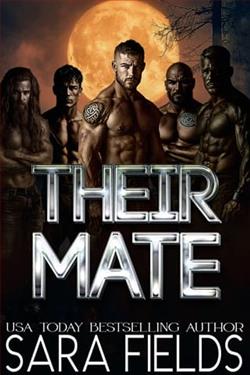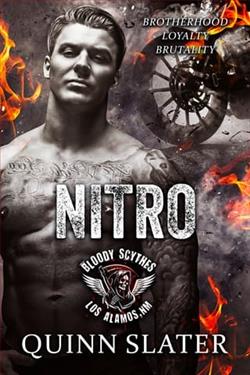Page 58 of Kiss Me Honey Hone
“I know,” Jack replied, the words cold, almost dismissive, before the line went dead.
“Fuck!” Kenny hurled his phone at the desk, the sharp crack of glass shattering as it ricocheted off the clutter of papers and books strewn across its surface.
His thoughts swirled in a chaotic mess. Taylor’s damning video, the spiralling whispers, the inevitable storm bearing down on Aaron. And how that would overshadow the real culprit here. He chewed on his thumbnail, staring blankly at the wall, his mind racing through a way to contain the fallout.
Then his watch beeped, jolting him back to reality. Nine a.m.
“Bollocks.” He was late.
Grabbing his bag, he yanked open the office door and stormed out. He rushed down the stairs, out across campus, into the lecture block and when he burst into Lecture Theatre Two, the atmosphere was palpably different. The usual buzz of pre-class chatter was subdued, replaced by hushed voices and furtive glances. A ripple of whispers spread through the room as he strode to the front, gaze sweeping over the rows of students.
Aaron wasn’t there.
He scanned the back row again, eyes catching on Mel and hoping she would reassure him he was on his way. But she gave a subtle shrug, expression solemn. Kenny exhaled, closing his eyes to centre himself. He had a lecture to give, a room full of students waiting for him to speak. But his mind was a mess.
A voice from the middle row jolted him, “Dr Lyons!”
He snapped his eyes open as a hand shot up from the girl. “Yes?”
“Have you seen the video about Child A?”
The question hung in the air, a fuse waiting to ignite, and the room fell silent, every student turning to watch him as they waited for his response. From the tension on their faces, thewhispers had already spread like wildfire. This wasn’t just curiosity. It was a demand for answers.
“Did you know there was a Howell child?” the girl pressed, gaining confidence from the group. “Is it true?”
Kenny ran a hand over his face and stepped away from the lectern, leaning back on the desk at the front of the room. Folding his arms, he stared down at the floor, chewing his bottom lip as he gathered his thoughts.
“Let this be today’s lesson,” he said, steady but edged with a tension that rippled through the room. “The media thrive on stories of good and evil. They crave villains and heroes, because those are the narratives that sell. They take fragments of truth, stitch them together with speculation, and present it as a complete picture. But often, it’s a picture that distorts reality.”
The students remained silent, his words pulling them in.
“I’m not here to validate or refute the existence of Child A,” Kenny continued, his voice hardening. “As you will learn, confidentiality is key, and any breaking of that confidentiality is career carnage. But what I will say is this: releasing speculative theories about an ongoing case is reckless. It doesn’t serve justice. It inflames fear, diverts attention from real evidence, and sabotages the very investigations meant to bring answers. Worse, it puts innocent people—people who’ve already endured unimaginable trauma—under the microscope of public scrutiny with no proof.”
He paused, letting the tension settle before continuing. “This kind of sensationalism taps into our natural need for closure. It exploits the human desire to understand why terrible things happen, even if the explanation is unfounded. And in doing so, it feeds a cycle of misinformation, which can destroy lives. Real, tangible lives.”
Kenny scanned the room again, landing briefly on the empty seat where Aaron should have been. His gut sank, but he forced himself to maintain his composure.
“What you’ve seen today is a lesson in hownotto handle a case like this. As future professionals—whether in psychology, media, or any other field—you must understand how your words and actions have consequences. What you say, what you publish, can ruin lives. It can compromise investigations. And it can create new victims in the name of chasing a story.”
The room was silent, the students hanging on his every word.
“So, ask yourselves.” Kenny took off his glasses, wiping his lenses on his sleeve. “Do you want to be the person who seeks the truth responsibly? Or the person who sets the world on fire because it makes for a better headline?”
He let the question linger, then straightened from the desk, putting his glasses back on. “That’s it. That’s today’s lecture. If you remember nothing else in your three years here, let it be that.”
He then grabbed his bag, marched to the door, and left.
* * * *
Thirty minutes later, Kenny stood outside the modest brick building that housed theRyston Gazette. Unimpressive, with a faded sign above the glass door proclaiming the newspaper’s name in peeling gold letters, with a “Buzz for Entry” sign taped haphazardly to the intercom beneath it. Kenny didn’t bother with the intercom. He banged his fist on the glass until a harried-looking receptionist peered out from behind the desk, face a mask of confusion and irritation. She hesitated before shuffling over to the door, unlocking it with a wary glance.
“Can I help you?”
“I need to speak to Carly Reynolds.” Kenny stepped inside without waiting for an invitation. The small lobby was dimly lit, with yellowed walls and the faint smell of stale coffee lingering in the air.
The receptionist frowned. “Do you have an appointment?”
Kenny’s patience was already threadbare. “No, but I’m not leaving without speaking to her.”















